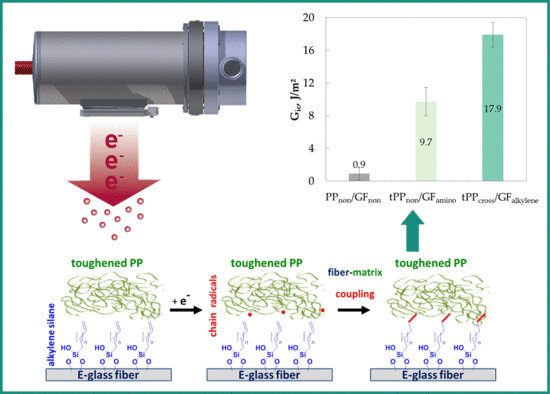Enhanced Interfacial Shear Strength and Critical Energy Release Rate in Single Glass Fiber-Crosslinked Polypropylene Model Microcomposites
Abstract
:1. Introduction
2. Experiment Section
2.1. Experiment
2.1.1. Materials and Specimen Preparation
2.1.2. Pull-Out Testing
2.1.3. Sample Designation and Composition of Single GF–PP Model Microcomposites
2.1.4. Scanning Electron Microscopy (SEM)
3. Results and Discussion
3.1. Force-Displacement Curves
3.2. Evaluation of Pull-Out Test
3.3. Evaluation of GF Surface after the Pull-Out Test
4. Conclusions
Author Contributions
Funding
Acknowledgments
Conflicts of Interest
References
- Composites Market Report 2017: Market Developments, Trends, Outlook and Challenges. Available online: https://pultruders.org/documents/Composites_Market_Report_2017.pdf (accessed on 14 November 2018).
- Modler, N.; Hufenbach, W.; Cherif, C.; Ulbricht, V.; Gude, M.; Maron, B.; Weck, D.; Filippatos, A.; Wiemer, H.; Langkamp, A. Novel hybrid yarn textile thermoplastic composites for function-integrating multi-material lightweight design. Adv. Eng. Mater. 2016, 18, 361–368. [Google Scholar] [CrossRef]
- Merter, N.E.; Başer, G.; Tanoğlu, M. Effects of hybrid yarn preparation technique and fiber sizing on the mechanical properties of continuous glass fiber-reinforced polypropylene composites. J. Compos. Mater. 2016, 50, 1697–1706. [Google Scholar] [CrossRef]
- Liebsch, A.; Kupfer, R.; Defranceski, A.; Rösler, B.; Janik, J.; Gude, M. Automated preforming of braided hoses made of thermoplast-glass fiber hybrid yarns. Procedia CIRP 2017, 66, 57–61. [Google Scholar] [CrossRef]
- Cech, V.; Knob, A.; Hosein, H.-A.; Babik, A.; Lepcio, P.; Ondreáš, F.; Drzal, L. Enhanced interfacial adhesion of glass fibers by tetravinylsilane plasma modification. Compos. Part A Appl. Sci. Manuf. 2014, 58, 84–89. [Google Scholar] [CrossRef]
- Knob, A.; Lukes, J.; Drzal, L.T.; Cech, V. Further progress in functional interlayers with controlled mecha-nical properties designed for glass fiber/polyester composites. Fibers 2018, 6, 58. [Google Scholar] [CrossRef]
- Petersen, H.N.; Kusano, Y.; Brøndsted, P.; Almdal, K. Preliminary characterization of glass fiber sizing. Proc. Risø Int. Symp. Mater. Sci. 2013, 34, 333–340. [Google Scholar]
- Li, S.; Lin, Q.; Zhu, H.; Hou, H.; Li, Y.; Wu, Q.; Cui, C. Improved mechanical properties of epoxy-based composites with hyperbranched polymer grafting glass-fiber. Polym. Adv. Technol. 2016, 27, 898–904. [Google Scholar] [CrossRef]
- Li, S.; Li, Y.; Zhu, H.; Lin, Q.; Hou, H.; Lv, T.; Wu, Q.; Cui, C. Evaluation of glass-fiber grafted by epoxide-terminated hyperbranched polymer on the effect of mechanical characterization of epoxy composites. Sci. Eng. Compos. Mater. 2018, 25, 417–423. [Google Scholar] [CrossRef]
- Brodowsky, H.; Mäder, E. Investigation of transcrystalline interphases in polypropylene/glass fiber composites using micromechanical tests. Fibers 2018, 6, 16. [Google Scholar] [CrossRef]
- Mäder, E.; Rothe, C.; Brünig, H.; Leopold, T. Online spinning of commingled yarns—Equipment and yarn modification by tailored fibre surfaces. Key Eng. Mater. 2007, 334–335, 229–232. [Google Scholar] [CrossRef]
- Eyckens, D.; Stojcevski, F.; Hendlmeier, A.J.; Arnold, C.; Randall, J.; Perus, M.D.; Servinis, L.; Gengenbach, T.R.; Demir, B.; Walsh, T.R.; et al. An efficient high-throughput grafting procedure for enhancing carbon fiber-to-matrix interactions in composites. Chem. Eng. J. 2018, 353, 373–380. [Google Scholar] [CrossRef]
- Xie, Y.; Hill, C.A.S.; Xiao, Z.; Militz, H.; Mai, C. Silane coupling agents used for natural fiber/polymer composites: A review. Compos. Part A 2010, 41, 806–819. [Google Scholar] [CrossRef]
- Etcheverry, M.; Barbosa, S.E. Glass fiber reinforced polypropylene mechanical properties enhancement by adhesion improvement. Materials 2012, 5, 1084–1113. [Google Scholar] [CrossRef] [PubMed]
- Clough, R.L. High-energy radiation and polymers: A review of commercial processes and emerging applications. Nucl. Instrum. Meth. B 2001, 185, 8–33. [Google Scholar] [CrossRef]
- Yoshii, F.; Meligi, G.; Sasaki, T.; Makuuchi, K.; Rabei, A.M.; Nishimato, S. Effect of irradiation on the degradability of polypropylene in the natural environment. Polym. Degrad. Stab. 1995, 49, 315–321. [Google Scholar] [CrossRef]
- Rätzsch, M.; Arnold, M.; Borsig, E.; Bucka, H.; Reichelt, N. Radical reactions on polypropylene in the solid state. Prog. Pol. Sci. 2002, 27, 1195–1282. [Google Scholar] [CrossRef]
- Krause, B.; Voigt, D.; Häußler, L.; Auhl, D.; Münstedt, H. Characterization of electron beam irradiated polypropylene: Influence of irradiation temperature on molecular and rheological properties. J. Appl. Poly. Sci. 2006, 100, 2770–2780. [Google Scholar] [CrossRef]
- Schulze, U.; Majumder, P.S.; Heinrich, G.; Stephan, M.; Gohs, U. Electron beam crosslinking of atactic poly(propylene): Development of a potential novel elastomer. Macromol. Mater. Eng. 2008, 293, 692–699. [Google Scholar] [CrossRef]
- Naskar, K.; Gohs, U.; Heinrich, G. Influence of molecular structure of blend components on the performance of thermoplastic vulcanisates prepared by electron induced reactive processing. Polymer 2016, 91, 203–210. [Google Scholar] [CrossRef]
- Zschech, C.; Miersch, F.; Gohs, U.; Heinrich, G. Electron-induced reactive processing of polypropylene/ethylene octene copolymer blends—A new method to produce toughened polypropylene. J. Plast. Technol. 2016, 12, 112–134. [Google Scholar] [CrossRef]
- Aghjeh, M.R.; Khonakdar, H.A.; Jafari, S.H.; Zschech, C.; Gohs, U.; Heinrich, G. Rheological, morphological and mechanical investigations on ethylene octene copolymer toughened polypropylene prepared by continuous electron induced reactive processing. RSC Adv. 2016, 6, 24651–24660. [Google Scholar] [CrossRef]
- Al-Rahhal, S.; Brünig, H.; Gohs, U.; Heinrich, G. Melt spun matrix fibers of toughened polypropylene copolymers modified by high energy electrons. J. Appl. Polym. Sci. 2016, 133, 44011. [Google Scholar] [CrossRef]
- Al-Rahhal, S.; Brünig, H.; Gohs, U.; Heinrich, G. Influence of electron induced reactive processing and secondary rubber phase on spinnability of polypropylene and polypropylene/rubber blends. Int. Poly. Process. 2018, 33, 60–65. [Google Scholar] [CrossRef]
- Gohs, U.; Girdauskaite, L.; Peitzsch, L.; Rothe, S.; Zschech, C.; Heinrich, G.; Rödel, H. Crosslinked continuous glass fiber reinforced toughened polypropylene composites. Adv. Eng. Mater. 2016, 18, 409–416. [Google Scholar] [CrossRef]
- Vautard, F.; Grappe, H.; Ozcan, S. Engineered interface chemistry to improve the strength of carbon fiber composites cured by electron beam. Ind. Eng. Chem. Res. 2014, 53, 12729. [Google Scholar] [CrossRef]
- Mäder, E.; Grundke, K.; Jacobasch, H.-J.; Wachinger, G. Surface, interphase and composite property relations in fibre-reinforced composites. Composites 1994, 25, 739–744. [Google Scholar] [CrossRef]
- Zhandarov, S.; Mäder, E. An alternative method of determining the local interfacial shear strength from force–displacement curves in the pull-out and microbond tests. Int. J. Adhes. Adhes. 2014, 55, 37–42. [Google Scholar] [CrossRef]
- Bogoeva-Gaceva, G.; Grozdanov, A. Crystallization of isotactic polypropylene: The effect of fiber surface. J. Serb. Chem. Soc. 2006, 71, 483–499. [Google Scholar] [CrossRef]
- Zhandarov, S.; Pisanova, E.; Lauke, B. Is there any contradiction between the stress and energy failure criteria in micromechanical tests? Part I. Crack initiation: stress-controlled or energy-controlled? Compos. Interfaces 1998, 5, 387–404. [Google Scholar] [CrossRef]
- Mendels, D.-A.; Leterrier, Y.; Månson, J.-A.E.; Nairn, J.A. The influence of internal stresses on the microbond test II: Physical aging and adhesion. J. Comput. Mater. 2002, 36, 1655–1676. [Google Scholar] [CrossRef]


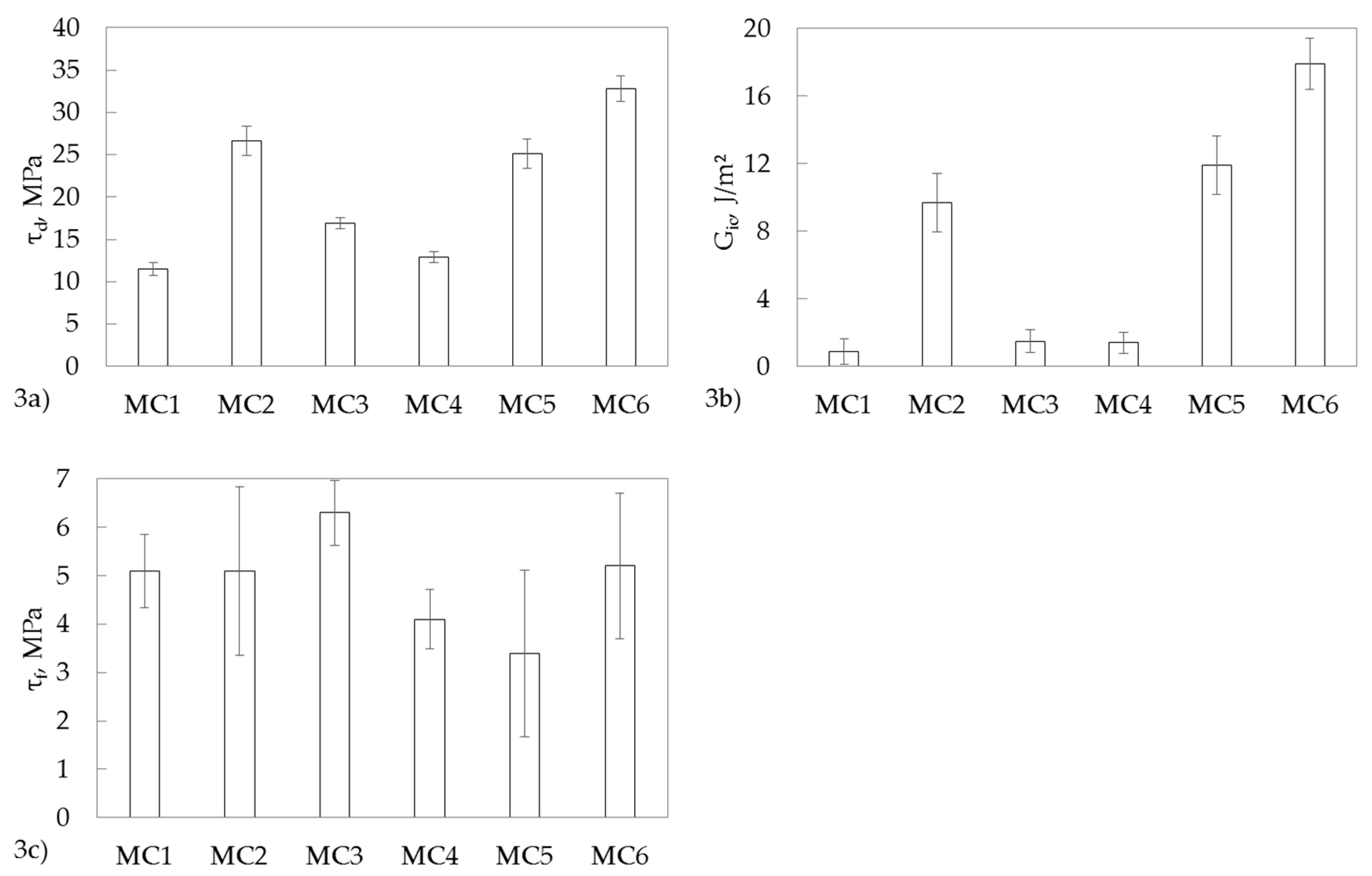
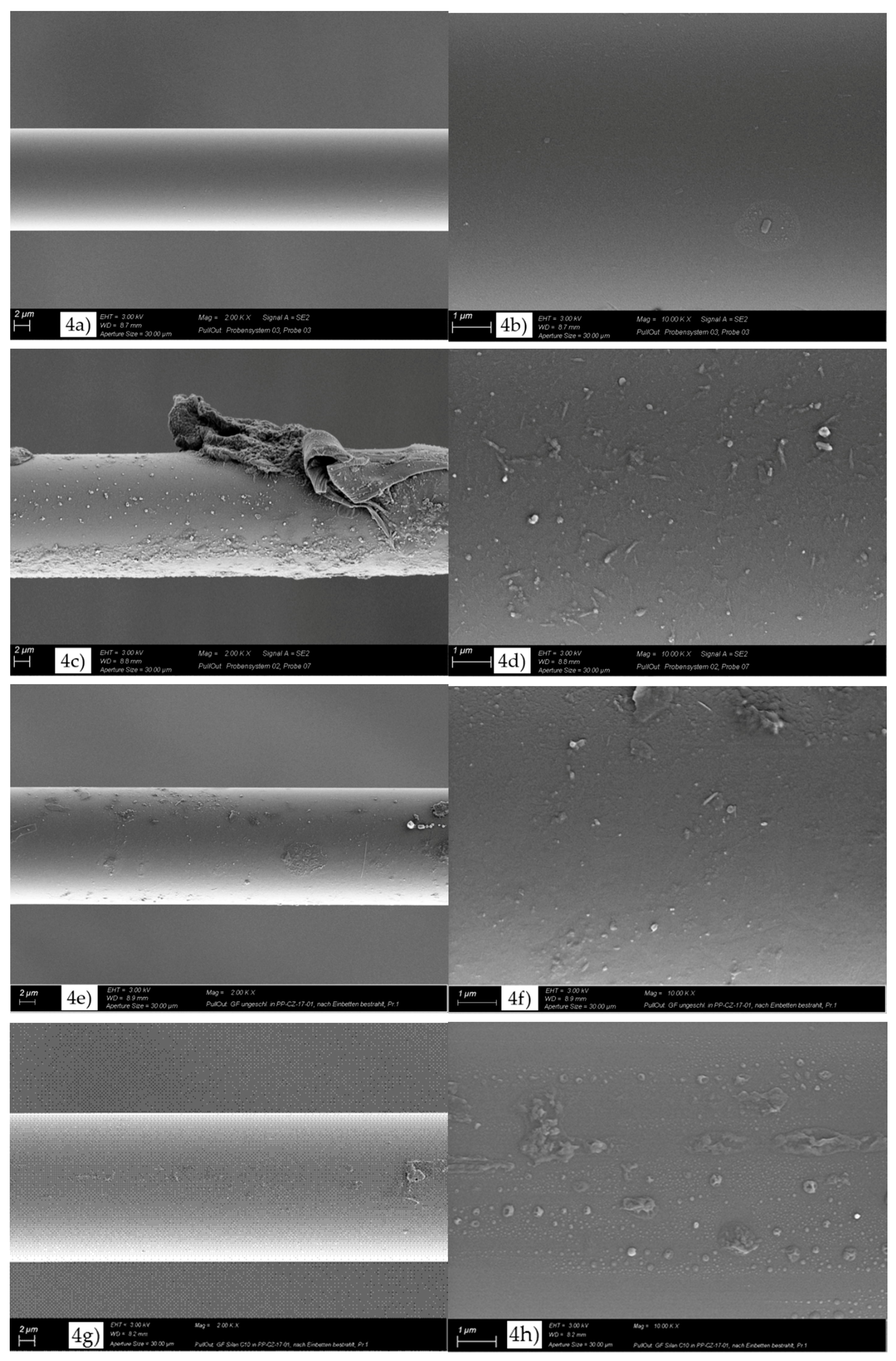
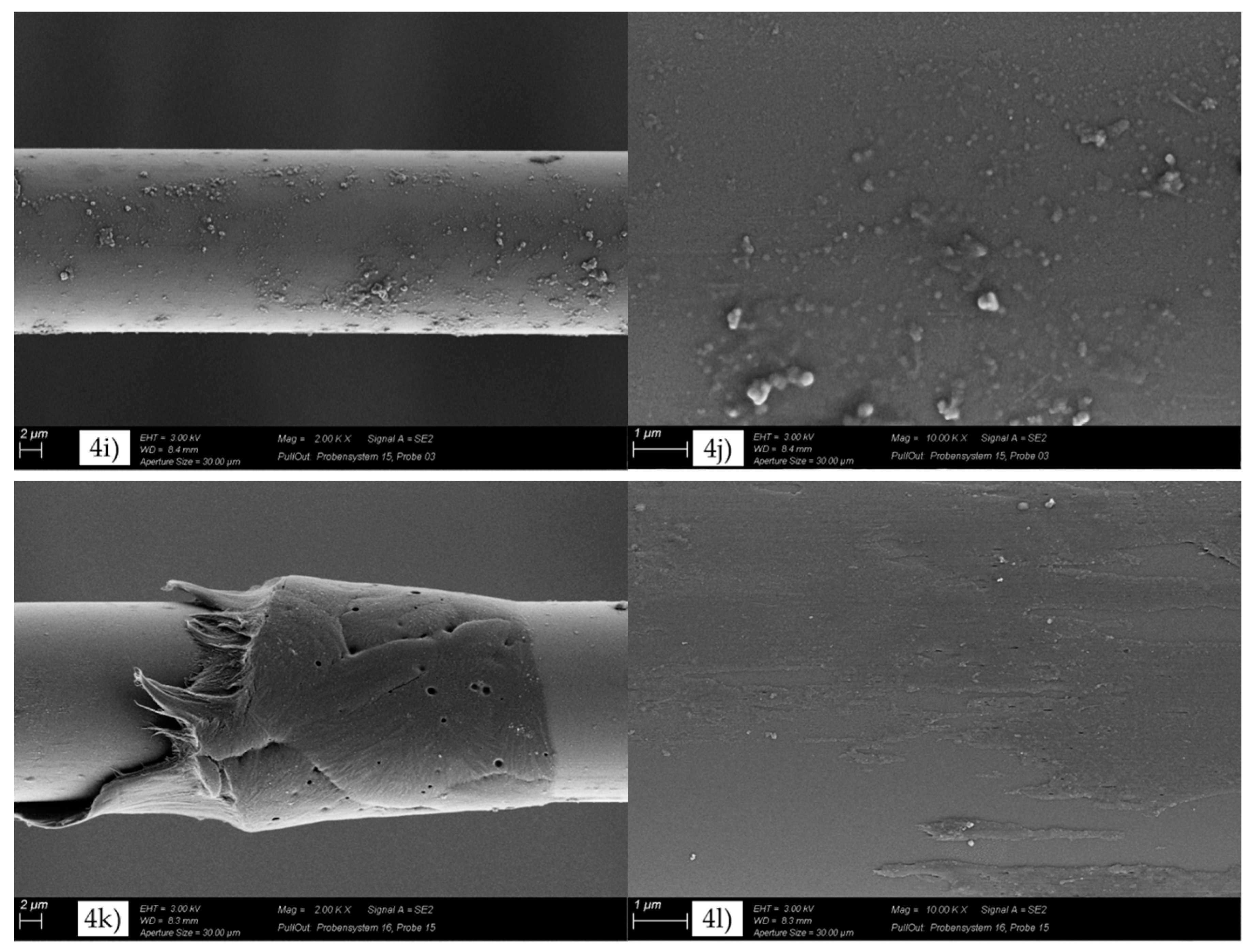
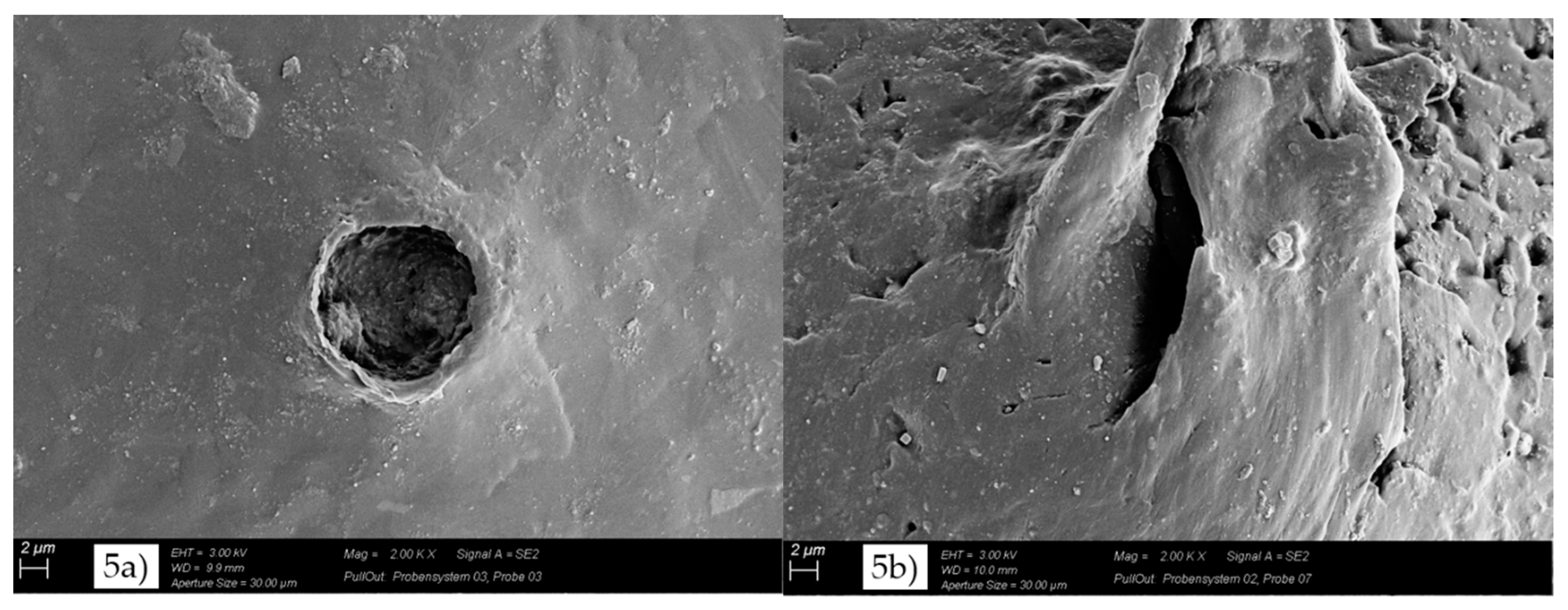
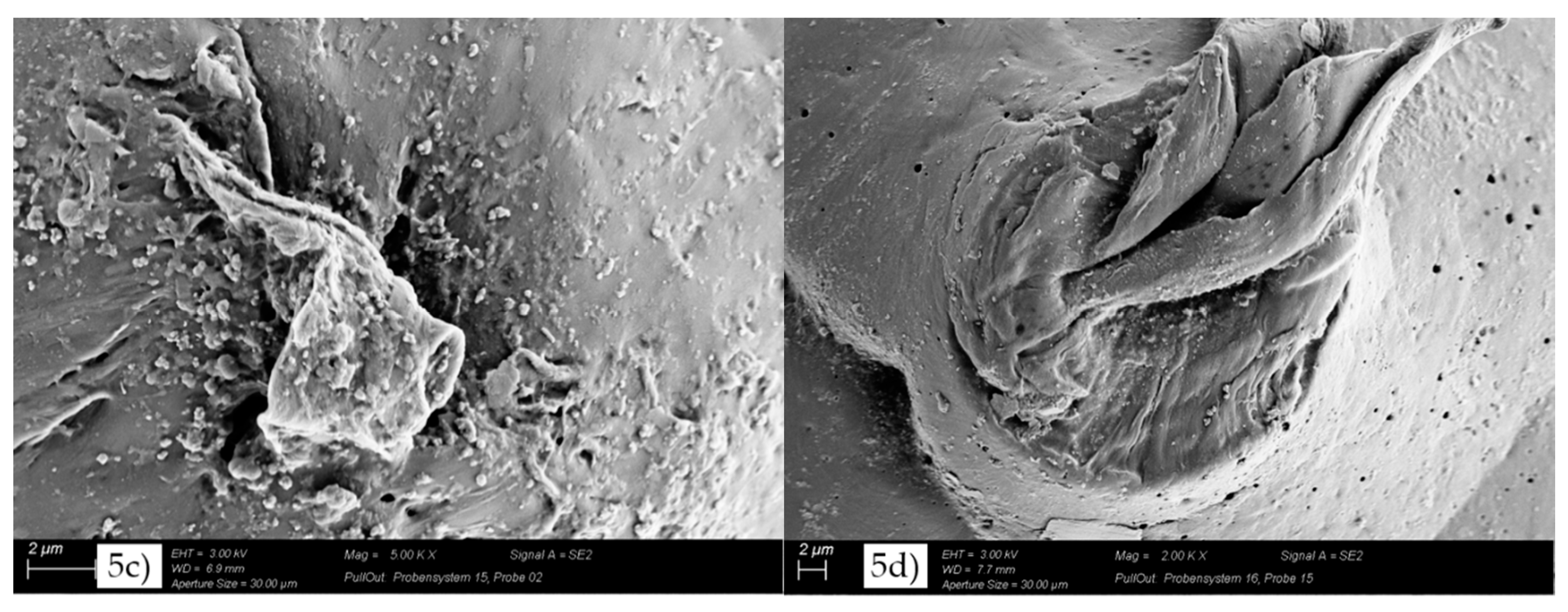
| Raw Material | Type | Supplier | Additional Information |
|---|---|---|---|
| polypropylene | PP HG455FB | Borealis AG, Linz, Austria | melt flow rate: 27 g/10 min (230 °C/2.16 kg) |
| ethylene octene copolymer | Engage 8100 | Dow Chemical Company, Midland, MI, USA | melt flow rate: 1.0 g/10 min (190 °C/2.16 kg) |
| maleic anhydride-grafted PP | Exxelor PO1020 | Exxon Mobil Corporation, Antwerp, Belgium | 0.5 to 1 ma % grafted maleic anhydride |
| trimethylol-propane triacrylate | Trimethylolpropane triacrylate (TMPTA) | Cytec Surface Specialities, Vlaardingen, The Netherlands | Chemical Abstracts Service (CAS): 15625-89-5trifunctional |
| PP-film former | Aquacer 598 | BYK-Chemie GmbH, Wesel, Germany | 0.25 to 0.5 ma % grafted maleic anhydride |
| adhesion promoter-1 | Dynasylan AMEO, 3-aminopropyl-triethoxysilane | Evonik Industries, Marl, Germany | CAS: 919-30-2 bifunctional |
| adhesion promoter-2 | 10-undecenyltrimethoxysilane | Gelest, Inc., Morrisville, NC, USA | CAS: 872575-06-9 bifunctional, for EB |
| adhesion promoter-3 | n-decyltrimethoxysilane | Gelest, Inc., Morrisville, NC, USA | CAS: 5575-48-4 monofunctional |
| Abbreviation | Composition |
|---|---|
| PPnon | blend of PP HG455FB (98 ma %) and Exxelor PO1020 (2 ma %), noncrosslinked |
| tPPnon | blend of PP HG455FB (94 ma %), Engage 8100 (2 ma %), TMPTA (2 ma %), and Exxelor PO1020 (2 ma %), noncrosslinked |
| tPPcross | blend of PP HG455FB (94 ma %), Engage 8100 (2 ma %), TMPTA (2 ma %), and Exxelor PO1020 (2 ma %), crosslinked |
| GFnon | nonfunctionalized GF, but pretreated (see Section 2.1.1.) |
| GFamino | GF sized with aqueous standard sizing consisting of a coupling agent (3-aminopropyl-triethoxysilane) and a film former (Aquacer 598) |
| GFalkyl | alkyl-functionalized GF |
| GFalkylene | alkylene-functionalized GF + 0 kGy |
| Sample Designation | Composition |
|---|---|
| MC1 | PPnon + GFnon |
| MC2 | PPnon + GFamino |
| MC3 | tPPcross + GFnon |
| MC4 | tPPcross + GFalkyl |
| MC5 | tPPnon + GFalkylene |
| MC6 | tPPcross + GFalkylene |
| Type | df, μm | le, μm | Fmax, N | Fb, N | τd, MPa | τf, MPa | Gic, J/m² |
|---|---|---|---|---|---|---|---|
| MC1 | 17.2 ± 0.3 | 592 ± 25 | 0.195 ± 0.009 | 0.163 ± 0.010 | 11.5 ± 0.8 | 5.5 ± 0.3 | 0.9 ± 0.4 |
| MC2 | 16.6 ± 0.2 | 615 ± 15 | 0.288 ± 0.098 | 0.163 ± 0.019 | 26.6 ± 1.7 | 5.1 ± 0.6 | 9.7 ± 1.3 |
| MC3 | 16.0 ± 0.4 | 633 ± 15 | 0.263 ± 0.014 | 0.216 ± 0.013 | 16.9 ± 0.7 | 6.3 ± 0.4 | 1.5 ± 0.2 |
| MC4 | 17.0 ± 0.8 | 680 ± 14 | 0.194 ± 0.014 | 0.146 ± 0.013 | 12.9 ± 0.6 | 4.1 ± 0.3 | 1.4 ± 0.3 |
| MC5 | 17.3 ± 0.4 | 655 ± 25 | 0.267 ± 0.023 | 0.122 ± 0.010 | 25.1 ± 1.7 | 3.4 ± 0.3 | 11.9 ± 1.9 |
| MC6 | 16.9 ± 0.3 | 620 ± 32 | 0.351 ± 0.029 | 0.166 ± 0.013 | 32.8 ± 1.5 | 5.2 ± 0.2 | 17.9 ± 2.5 |
© 2018 by the authors. Licensee MDPI, Basel, Switzerland. This article is an open access article distributed under the terms and conditions of the Creative Commons Attribution (CC BY) license (http://creativecommons.org/licenses/by/4.0/).
Share and Cite
Gohs, U.; Mueller, M.T.; Zschech, C.; Zhandarov, S. Enhanced Interfacial Shear Strength and Critical Energy Release Rate in Single Glass Fiber-Crosslinked Polypropylene Model Microcomposites. Materials 2018, 11, 2552. https://doi.org/10.3390/ma11122552
Gohs U, Mueller MT, Zschech C, Zhandarov S. Enhanced Interfacial Shear Strength and Critical Energy Release Rate in Single Glass Fiber-Crosslinked Polypropylene Model Microcomposites. Materials. 2018; 11(12):2552. https://doi.org/10.3390/ma11122552
Chicago/Turabian StyleGohs, Uwe, Michael Thomas Mueller, Carsten Zschech, and Serge Zhandarov. 2018. "Enhanced Interfacial Shear Strength and Critical Energy Release Rate in Single Glass Fiber-Crosslinked Polypropylene Model Microcomposites" Materials 11, no. 12: 2552. https://doi.org/10.3390/ma11122552




